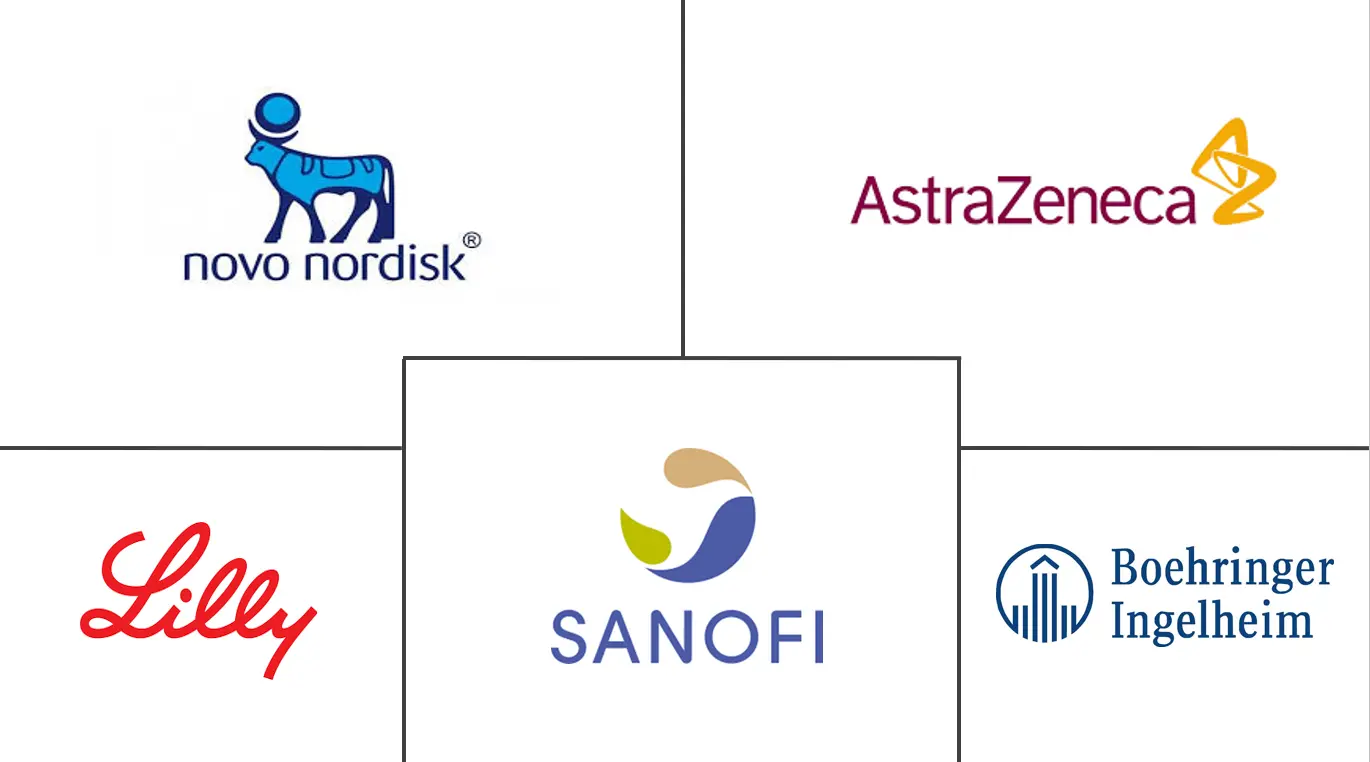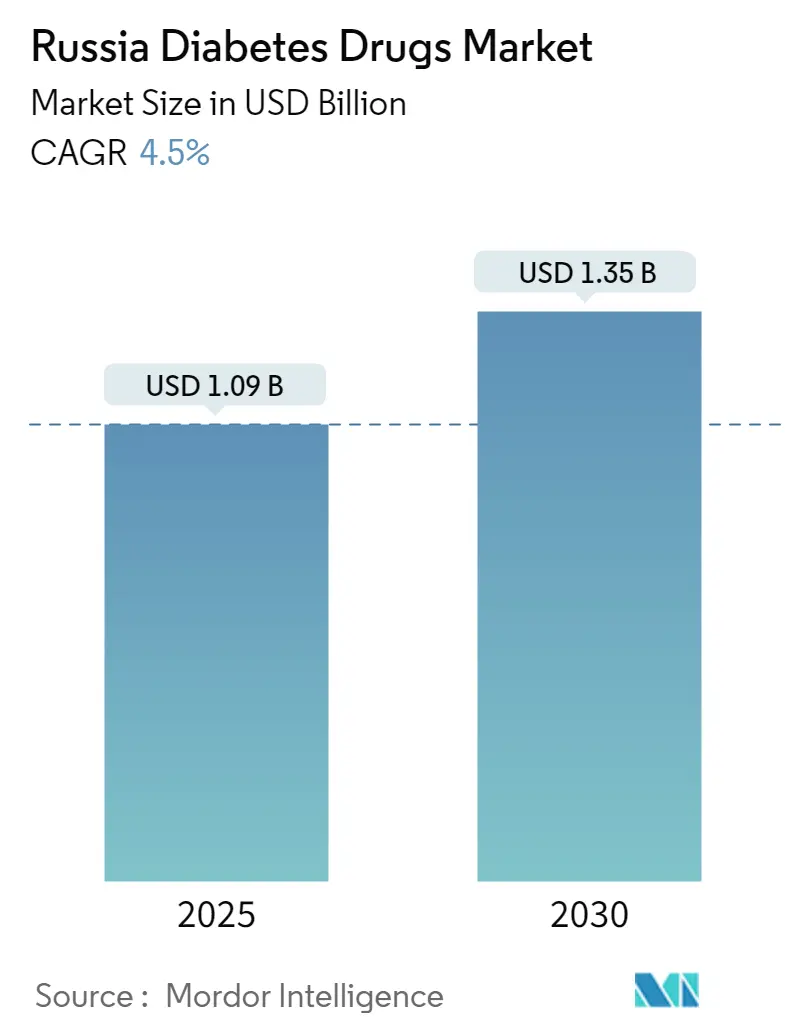
Russia Diabetes Drugs Market Analysis by Mordor Intelligence
The Russia Diabetes Drugs Market size is estimated at USD 1.09 billion in 2025, and is expected to reach USD 1.35 billion by 2030, at a CAGR of 4.5% during the forecast period (2025-2030).
The rising prevalence of diabetes in Russia is a concerning trend that is having a significant impact on the healthcare industry, particularly in the diabetes drugs market. Diabetes is a chronic disease characterized by high blood sugar levels, and it affects millions of people worldwide. In recent years, the number of people diagnosed with diabetes in Russia has been steadily increasing, leading to a surge in demand for diabetes drugs.
There are several factors contributing to the rising prevalence of diabetes in Russia. One of the primary factors is the changing lifestyle and dietary habits of the population. With the rapid urbanization and modernization of the country, there has been a shift towards a sedentary lifestyle and the consumption of unhealthy, processed foods. These factors, combined with genetic predisposition, have led to an alarming increase in the number of people developing diabetes.
As the number of people diagnosed with diabetes continues to rise, the demand for diabetes drugs has also increased significantly. Diabetes drugs are essential for managing the disease and preventing complications. They help regulate blood sugar levels, improve insulin sensitivity, and reduce the risk of cardiovascular diseases associated with diabetes. As a result, the diabetes drugs market in Russia has experienced substantial growth in recent years.
In conclusion, the rising prevalence of diabetes in Russia is driving the growth of the diabetes drugs market. The changing lifestyle and dietary habits, along with genetic factors, have contributed to the increasing number of people diagnosed with diabetes. As a result, there is a growing demand for diabetes drugs in the country. Pharmaceutical companies are investing in research and development to meet this demand, while the government is implementing initiatives to address the diabetes epidemic. However, the high cost of diabetes drugs remains.
Therefore, owing to the aforementioned factors the studied market is anticipated to witness growth over the analysis period.
Russia Diabetes Drugs Market Trends and Insights
The oral anti-diabetic drugs segment holds the highest market share in the Russia Diabetes Drugs Market in the current year
Oral Anti-Diabetic Drugs are available internationally and are recommended for use when escalation of treatment for type 2 diabetes is required along with lifestyle management. Oral agents are typically the first medications used in treating type 2 diabetes due to their wide range of efficacy, safety, and mechanisms of action. Anti-diabetic drugs help diabetes patients control their condition and lower the risk of diabetes complications. People with diabetes may need to take anti-diabetic drugs for their whole lives to control their blood glucose levels and avoid hypoglycemia and hyperglycemia. Oral anti-diabetic agents present the advantages of easier management and lower cost. So they became an attractive alternative to insulin with better acceptance, which enhances adherence to the treatment.
Russia witnessed an alarming increase in the prevalence of diabetes in recent years. Patients with diabetes require many corrections throughout the day to maintain nominal blood glucose levels, such as oral anti-diabetic medication or ingestion of additional carbohydrates by monitoring their blood glucose levels. The rate of newly diagnosed Type 1 and Type 2 diabetes cases is seen to increase, mainly due to obesity, unhealthy diet, and physical inactivity.
According to IDF, to reduce the diabetes epidemic in the country, the Russian government needs to fully implement a National Diabetes Plan that establishes a state budget and guarantees diabetes care to all Russian citizens. Russia is working towards improving the reimbursement system for all aspects of diabetes care, limiting out-of-pocket payments, and preventing households from incurring catastrophic expenditures. Also, implementing a national screening program to improve the early identification of disturbed carbohydrate metabolism and creating a specialized diabetes health service under the Ministry of Health of the Russian Federation.
Owing to the above factors, the market will likely continue to grow.
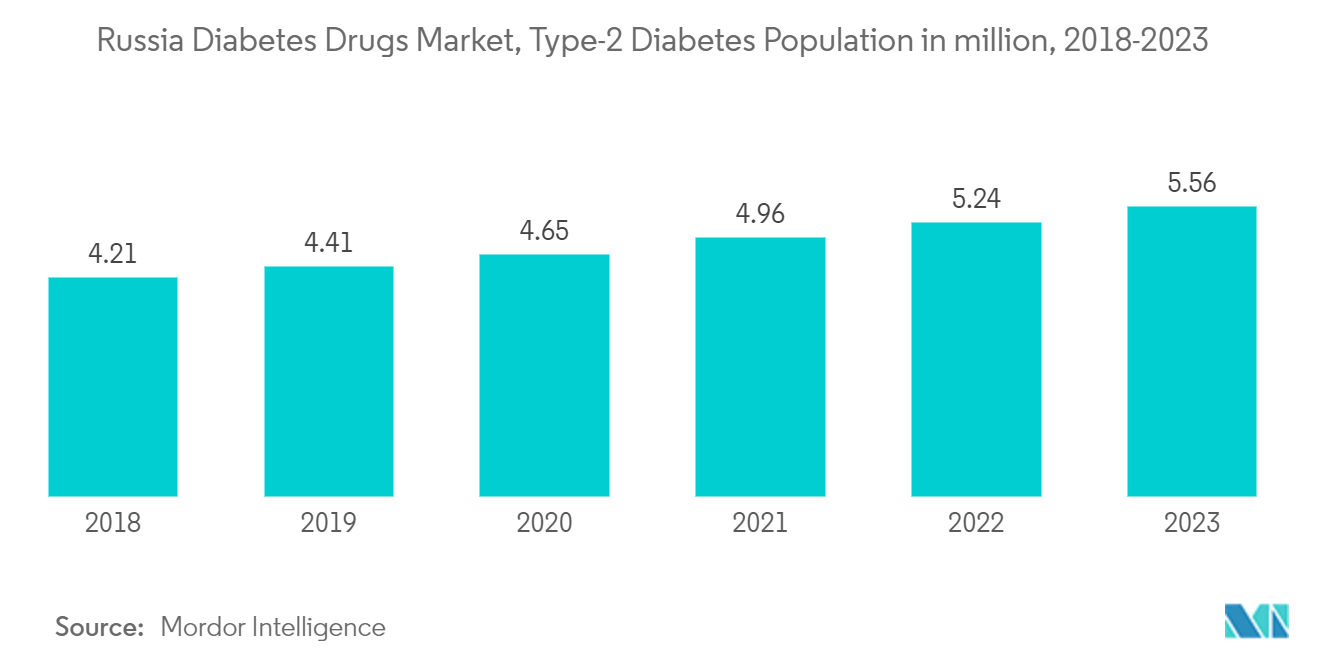
Sodium-glucose cotransport -2 (SGLT-2) inhibitor segment is expected to register the highest CAGR in the Russia Diabetes Drugs Market
Sodium-glucose cotransport -2 (SGLT-2) inhibitor segment is expected to register a CAGR of about 11.7% over the forecast period.
SGLT-2 inhibitors, also called gliflozins, are a medicine class used to lower high blood glucose levels in people with type 2 diabetes. SGLT-2 inhibitors act independently of beta-cell function in the pancreas. SGLT-2 drugs significantly manage cardiovascular risk factors, including blood pressure, cardiac function, and antiinflammatory activity. SGLT-2 inhibitors are effective at lowering hemoglobin A1c levels and improving weight loss. They include a low risk of hypoglycemia and are usually well tolerated. Technological advancements increased over the period leading to several modifications in the SGLT-2 inhibitors or the formulations being developed.
According to Roscongress, Russia ranks fifth in the world regarding the number of patients with diabetes mellitus aged 20 to 79. The growing diabetic population acts as a driver for diabetes care devices. In obese individuals, the fat cells in the body release pro-inflammatory chemicals, which may make the body less sensitive to the insulin it produces by disrupting the function of insulin-responsive cells. Russia's Federal Targeted Program on Diabetes states that diagnosing diabetes and treating its complications earlier can result in significant savings.
Various initiatives are launched to control diabetes in the country. For instance, in Moscow Urban Forum 2021, a Letter of Intent was signed between the Youth Council under the Moscow Department of Health, Moscow Urban Forum, Moscow Diabetic Association, Moscow Diabetic Association Medical Section, KB Strelka, and Novo Nordisk to implement the Cities Changing Diabetes program in Moscow. The program in Moscow aims to comprehensively assess the features of diabetes challenges relevant to Moscow. The program also implemented the development of an action plan to combat this disease among the most vulnerable groups of the population.
The roll-out of many new products, increasing international research collaborations in technology advancement, and increasing awareness about diabetes among people are some of the market opportunities for the players in the Russian diabetes drugs market.
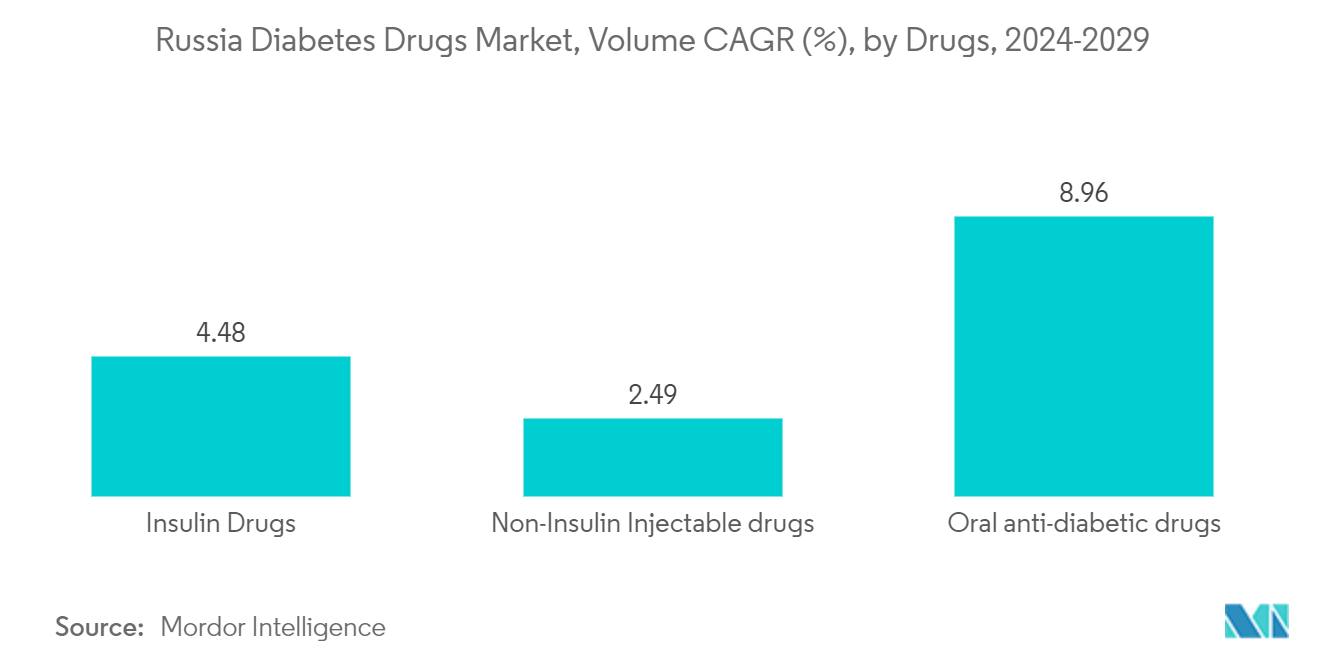
Competitive Landscape
The Russia Diabetes Drugs Market is moderately consolidated, with major manufacturers, namely Eli Lilly, Sanofi, Novo Nordisk, AstraZeneca, and other generic players, holding a presence in the region. A major share of the market is held by manufacturers concomitant with strategy-based M&A operations and constantly entering the market to generate new revenue streams and boost existing ones.
Russia Diabetes Drugs Industry Leaders
-
AstraZeneca
-
Eli Lilly
-
Boehringer Ingelheim
-
Novo Nordisk A/S
-
Sanofi Aventis
- *Disclaimer: Major Players sorted in no particular order
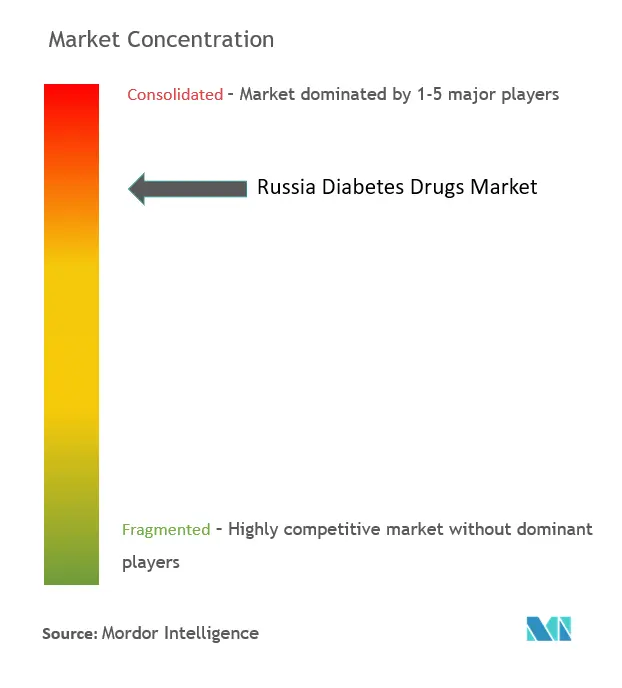
Recent Industry Developments
- February 2023: AstraZeneca's Forxiga (dapagliflozin) was approved in the European Union to extend the indication for heart failure with reduced ejection fraction to cover patients across the full spectrum of left ventricular ejection fraction. It includes heart failure with mildly reduced and preserved ejection fraction.
- March 2022: Eli Lilly and Boehringer Ingelheim gained approval for heart failure treatment from the EU for sodium-glucose co-transporter-2-inhibitor, Jardiance (empagliflozin).
Russia Diabetes Drugs Market Report Scope
Diabetes Drugs are used to manage diabetes mellitus by lowering the glucose level in the blood. The Russia Diabetes Drugs Market is segmented into insulin drugs, oral anti-diabetic drugs, non-insulin injectable drugs, and combination drugs. The report offers the value (in USD) and volume (in unit) for the above segments.
| Basal or Long Acting Insulins | Lantus (Insulin Glargine) |
| Levemir (Insulin Detemir) | |
| Toujeo (Insulin Glargine) | |
| Tresiba (Insulin Degludec) | |
| Basaglar (Insulin Glargine) | |
| Bolus or Fast Acting Insulins | NovoRapid/Novolog (Insulin Aspart) |
| Humalog (Insulin Lispro) | |
| Apidra (Insulin Glulisine) | |
| Traditional Human Insulins | Novolin/Actrapid/Insulatard |
| Humulin | |
| Insuman | |
| Biosimilar Insulins | Insulin Glargine Biosimilars |
| Human Insulin Biosimilars |
| Biguanides | Metformin |
| Alpha-Glucosidase Inhibitors | Alpha-Glucosidase Inhibitors |
| Dopamine D2 receptor agonist | Bromocriptin |
| SGLT-2 inhibitors | Invokana (Canagliflozin) |
| Jardiance (Empagliflozin) | |
| Farxiga/Forxiga (Dapagliflozin) | |
| Suglat (Ipragliflozin) | |
| DPP-4 inhibitors | Onglyza (Saxagliptin) |
| Tradjenta (Linagliptin) | |
| Vipidia/Nesina(Alogliptin) | |
| Galvus (Vildagliptin) | |
| Sulfonylureas | Sulfonylureas |
| Meglitinides | Meglitinides |
| GLP-1 receptor agonists | Victoza (Liraglutide) |
| Byetta (Exenatide) | |
| Bydureon (Exenatide) | |
| Trulicity (Dulaglutide) | |
| Lyxumia (Lixisenatide) | |
| Amylin Analogue | Symlin (Pramlintide) |
| Insulin combinations | NovoMix (Biphasic Insulin Aspart) |
| Ryzodeg (Insulin Degludec and Insulin Aspart) | |
| Xultophy (Insulin Degludec and Liraglutide) | |
| Oral Combinations | Janumet (Sitagliptin and Metformin) |
| Insulins | Basal or Long Acting Insulins | Lantus (Insulin Glargine) |
| Levemir (Insulin Detemir) | ||
| Toujeo (Insulin Glargine) | ||
| Tresiba (Insulin Degludec) | ||
| Basaglar (Insulin Glargine) | ||
| Bolus or Fast Acting Insulins | NovoRapid/Novolog (Insulin Aspart) | |
| Humalog (Insulin Lispro) | ||
| Apidra (Insulin Glulisine) | ||
| Traditional Human Insulins | Novolin/Actrapid/Insulatard | |
| Humulin | ||
| Insuman | ||
| Biosimilar Insulins | Insulin Glargine Biosimilars | |
| Human Insulin Biosimilars | ||
| Oral Anti-diabetic drugs | Biguanides | Metformin |
| Alpha-Glucosidase Inhibitors | Alpha-Glucosidase Inhibitors | |
| Dopamine D2 receptor agonist | Bromocriptin | |
| SGLT-2 inhibitors | Invokana (Canagliflozin) | |
| Jardiance (Empagliflozin) | ||
| Farxiga/Forxiga (Dapagliflozin) | ||
| Suglat (Ipragliflozin) | ||
| DPP-4 inhibitors | Onglyza (Saxagliptin) | |
| Tradjenta (Linagliptin) | ||
| Vipidia/Nesina(Alogliptin) | ||
| Galvus (Vildagliptin) | ||
| Sulfonylureas | Sulfonylureas | |
| Meglitinides | Meglitinides | |
| Non-Insulin Injectable drugs | GLP-1 receptor agonists | Victoza (Liraglutide) |
| Byetta (Exenatide) | ||
| Bydureon (Exenatide) | ||
| Trulicity (Dulaglutide) | ||
| Lyxumia (Lixisenatide) | ||
| Amylin Analogue | Symlin (Pramlintide) | |
| Combination drugs | Insulin combinations | NovoMix (Biphasic Insulin Aspart) |
| Ryzodeg (Insulin Degludec and Insulin Aspart) | ||
| Xultophy (Insulin Degludec and Liraglutide) | ||
| Oral Combinations | Janumet (Sitagliptin and Metformin) | |
Key Questions Answered in the Report
How big is the Russia Diabetes Drugs Market?
The Russia Diabetes Drugs Market size is expected to reach USD 1.09 billion in 2025 and grow at a CAGR of 4.5% to reach USD 1.35 billion by 2030.
What is the current Russia Diabetes Drugs Market size?
In 2025, the Russia Diabetes Drugs Market size is expected to reach USD 1.09 billion.
Who are the key players in Russia Diabetes Drugs Market?
AstraZeneca, Eli Lilly, Boehringer Ingelheim, Novo Nordisk A/S and Sanofi Aventis are the major companies operating in the Russia Diabetes Drugs Market.
What years does this Russia Diabetes Drugs Market cover, and what was the market size in 2024?
In 2024, the Russia Diabetes Drugs Market size was estimated at USD 1.04 billion. The report covers the Russia Diabetes Drugs Market historical market size for years: 2019, 2020, 2021, 2022, 2023 and 2024. The report also forecasts the Russia Diabetes Drugs Market size for years: 2025, 2026, 2027, 2028, 2029 and 2030.
Page last updated on:
Russia Diabetes Drugs Market Report
Statistics for the 2025 Russia Diabetes Drugs market share, size and revenue growth rate, created by Mordor Intelligence™ Industry Reports. Russia Diabetes Drugs analysis includes a market forecast outlook for 2025 to 2030 and historical overview. Get a sample of this industry analysis as a free report PDF download.
